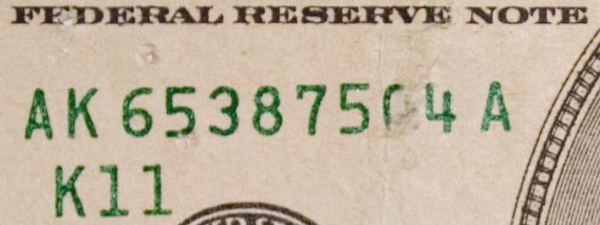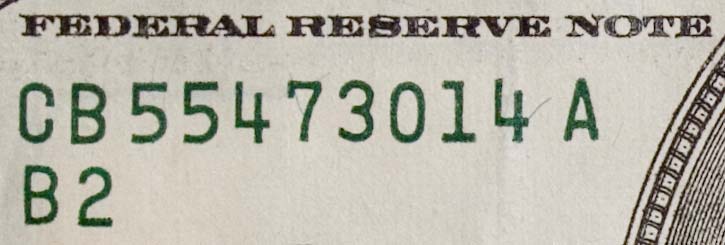We have mentioned here previously the new high-tech anti-counterfeitting features of the new $100, and that they pose no obstacle to fraudsters, who can just go on using the old non-holographic versions.
Of course even the best counterfeit money is by far imperfect, often displaying notably different fonts and colors. Armed with a sharp eye and knowledge of what to look for, anyone can tell the genuine article apart from the fakes. To supply this knowledge, we are creating a four-part series of short how-tos on spotting the fake C-notes among the real ones. Part one, about serial numbers, is below.
This is a closeup of the serial numbers on a genuine $100. Note the darkish-green color of the writing, and the even spaces between the numbers and letters.

Counterfeiters cannot replicate the colors used by the US Treasury. Pay particular attention to the green ink used to print seals and serial numbers on the bank notes. The color used on the Serial number should be dark green and consistent throughout the entire serial number. There should be no color fading or chipping. The color should match exactly the ink used for printing the Treasury Seal. The numbers should be uniformly spaced and level.
Now let's look at a fake bill.

Right away you can see the lighter shade of green used on the serial numbers. This is precisely why counterfeitters prefer to hand over their bills in dimly lit locations, like bars. Also notice the wear on the 0 at the top row, another sure sign of tampering. Finally, notice how off the spacing is: the second row is indented to the right, and placed so far down on the bill that it almost overlaps with the seal. Anytime you notice any irregular spacing of this sort, you are almost certainly dealing with a forgery.
Serial numbers are just one of the ways you can tell apart fake bills. There are also color-shifting numbers, small lettering on the portrait, and very fine lines you can actually feel with your hand. All of which we will bring you in parts two through four in the coming days.


